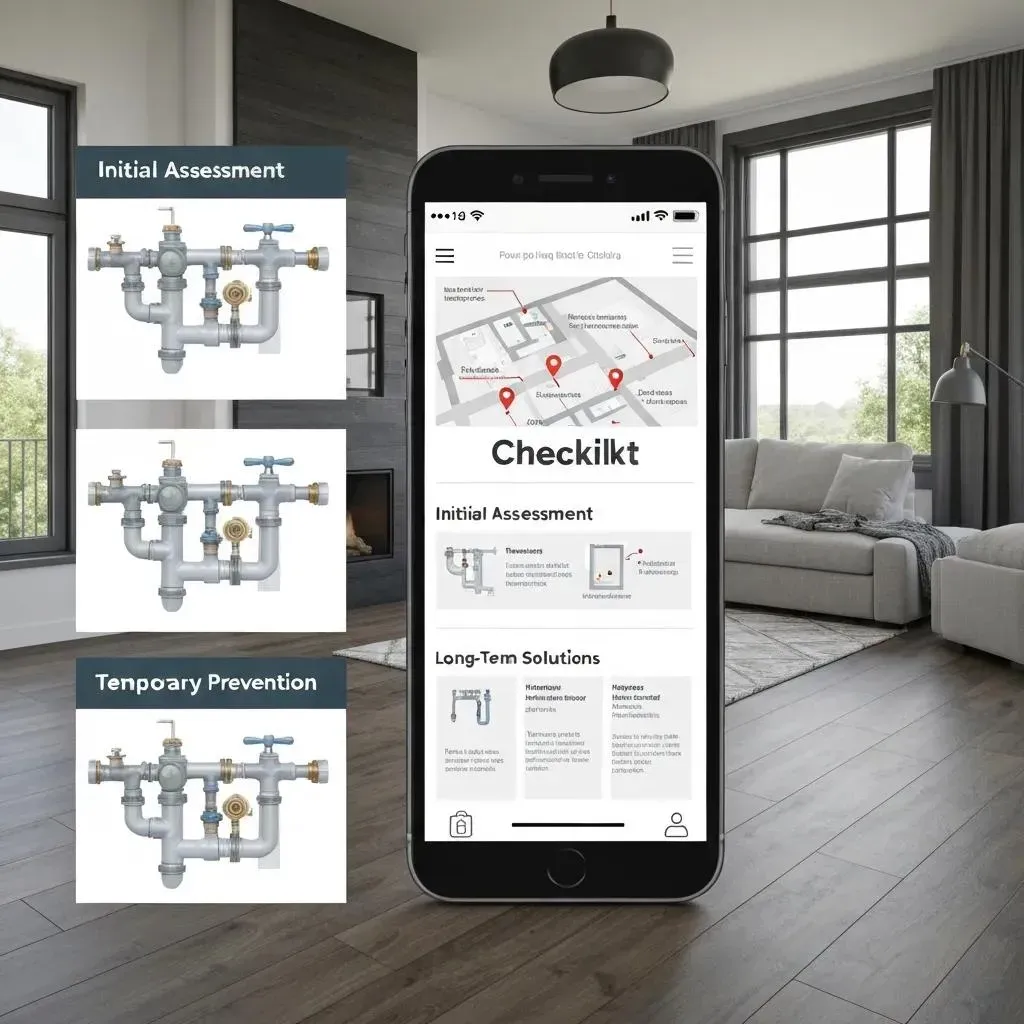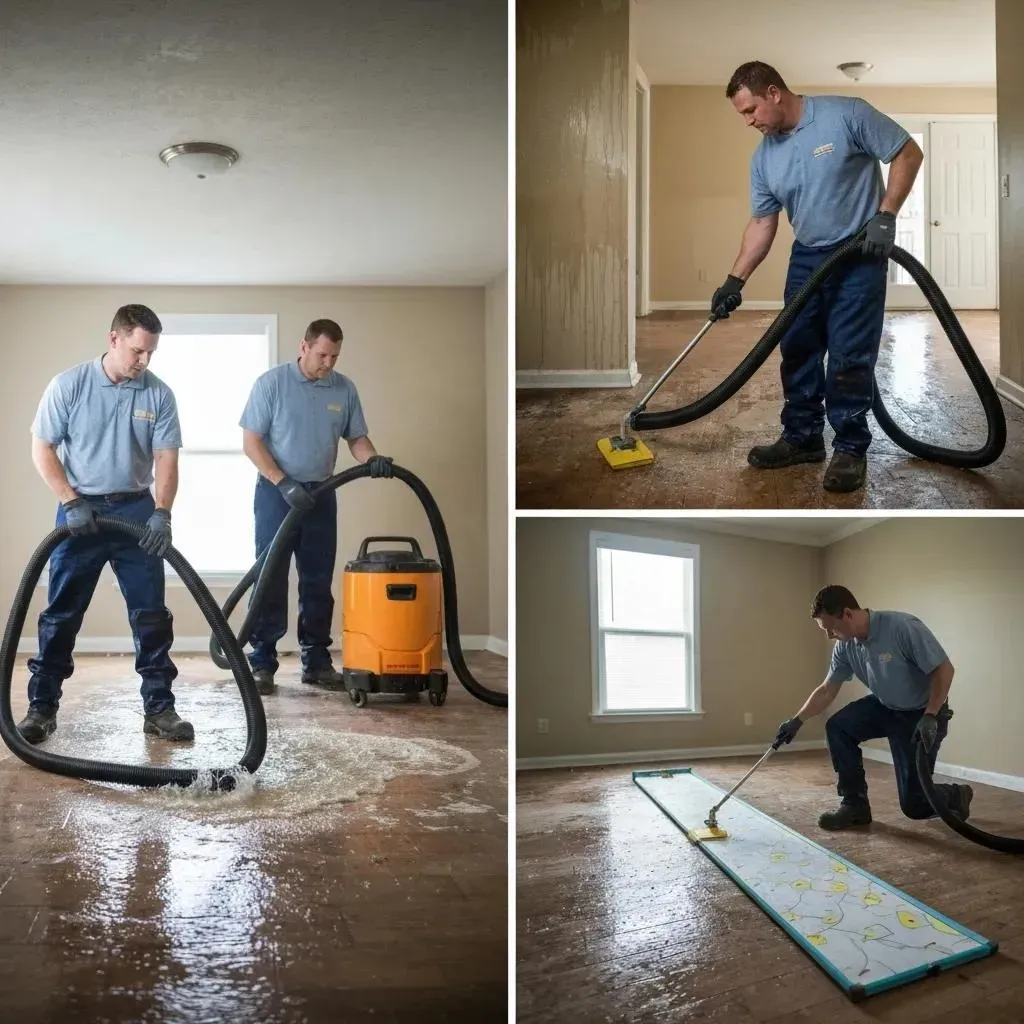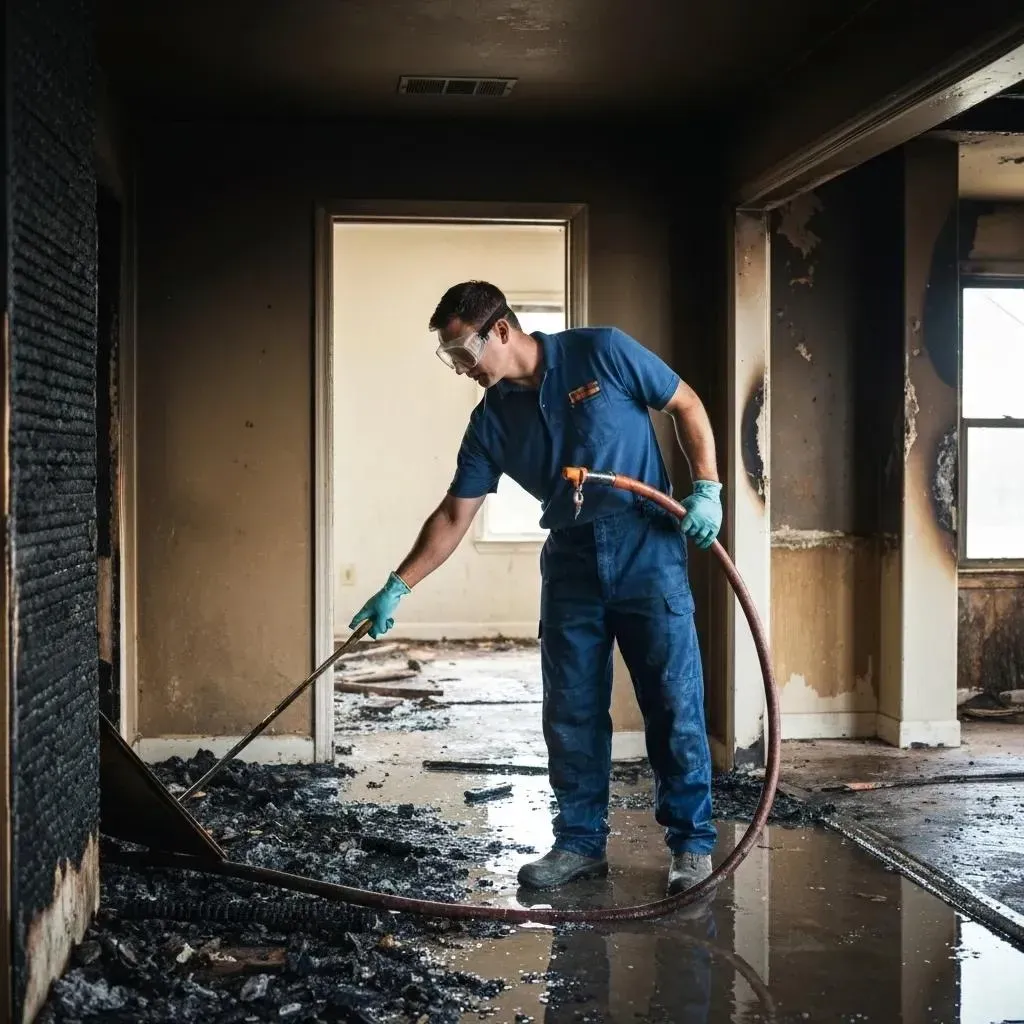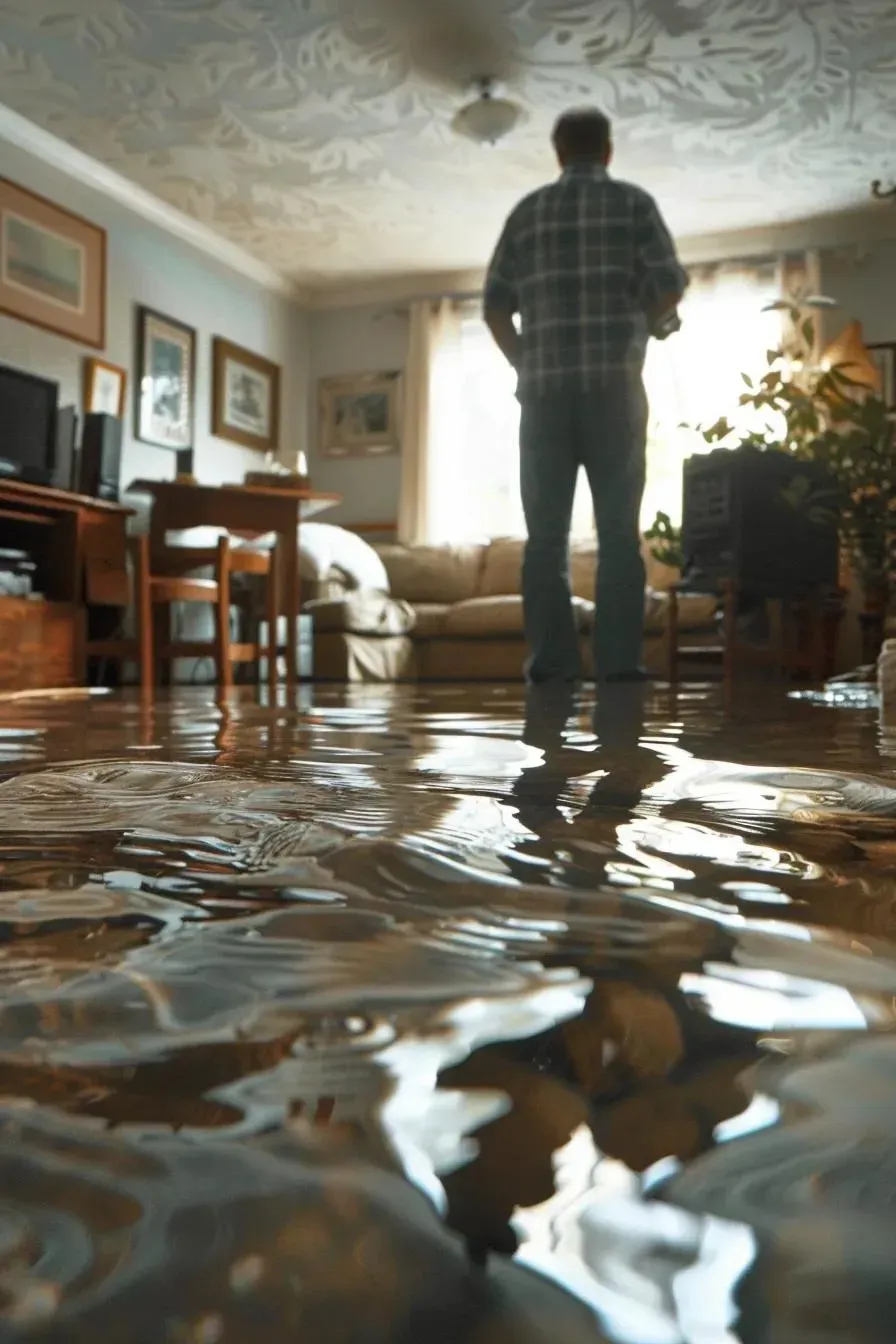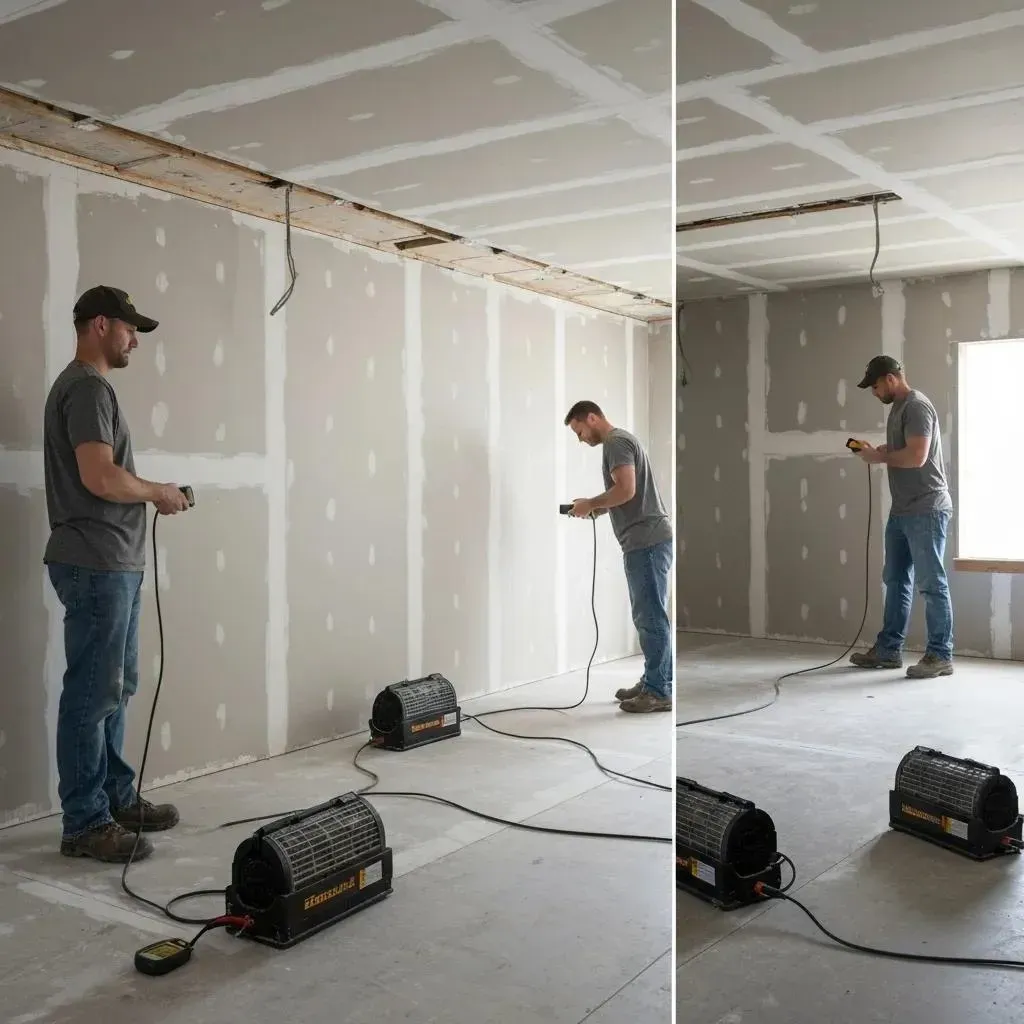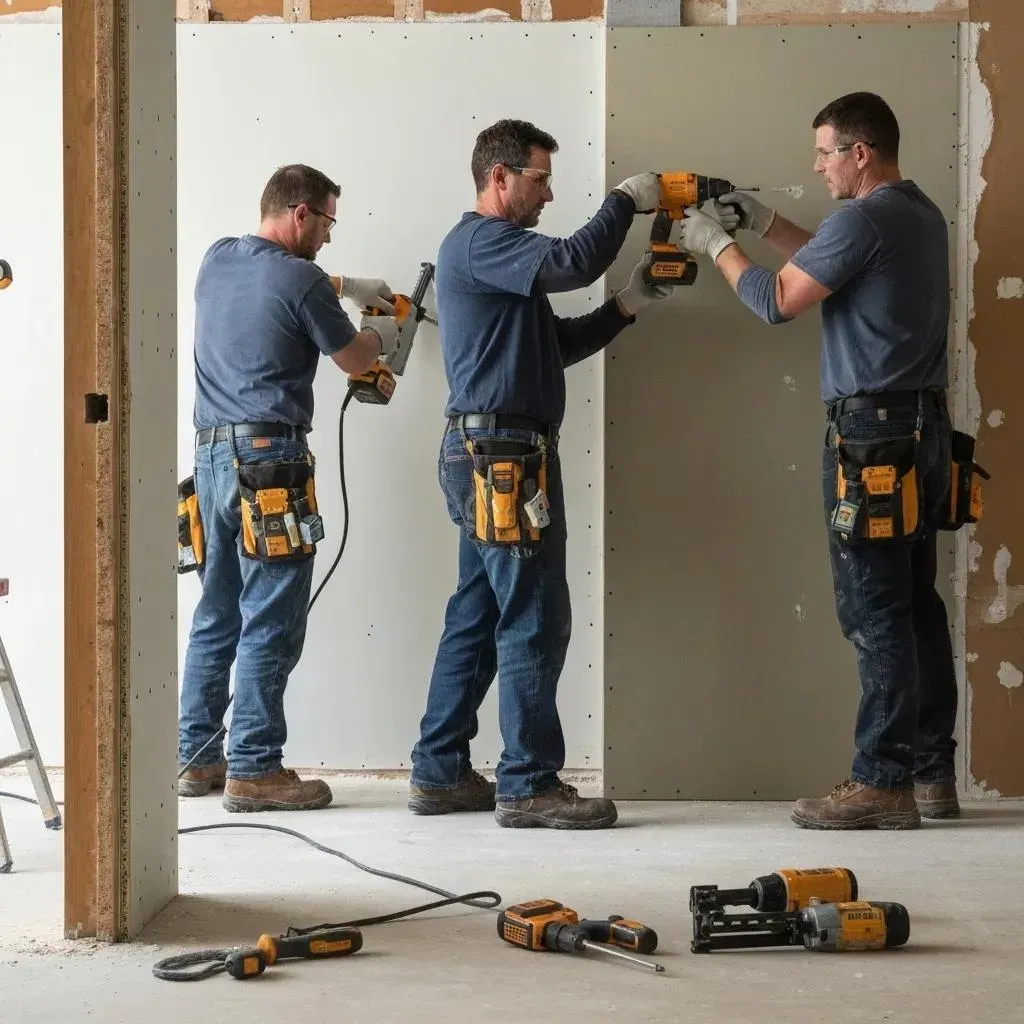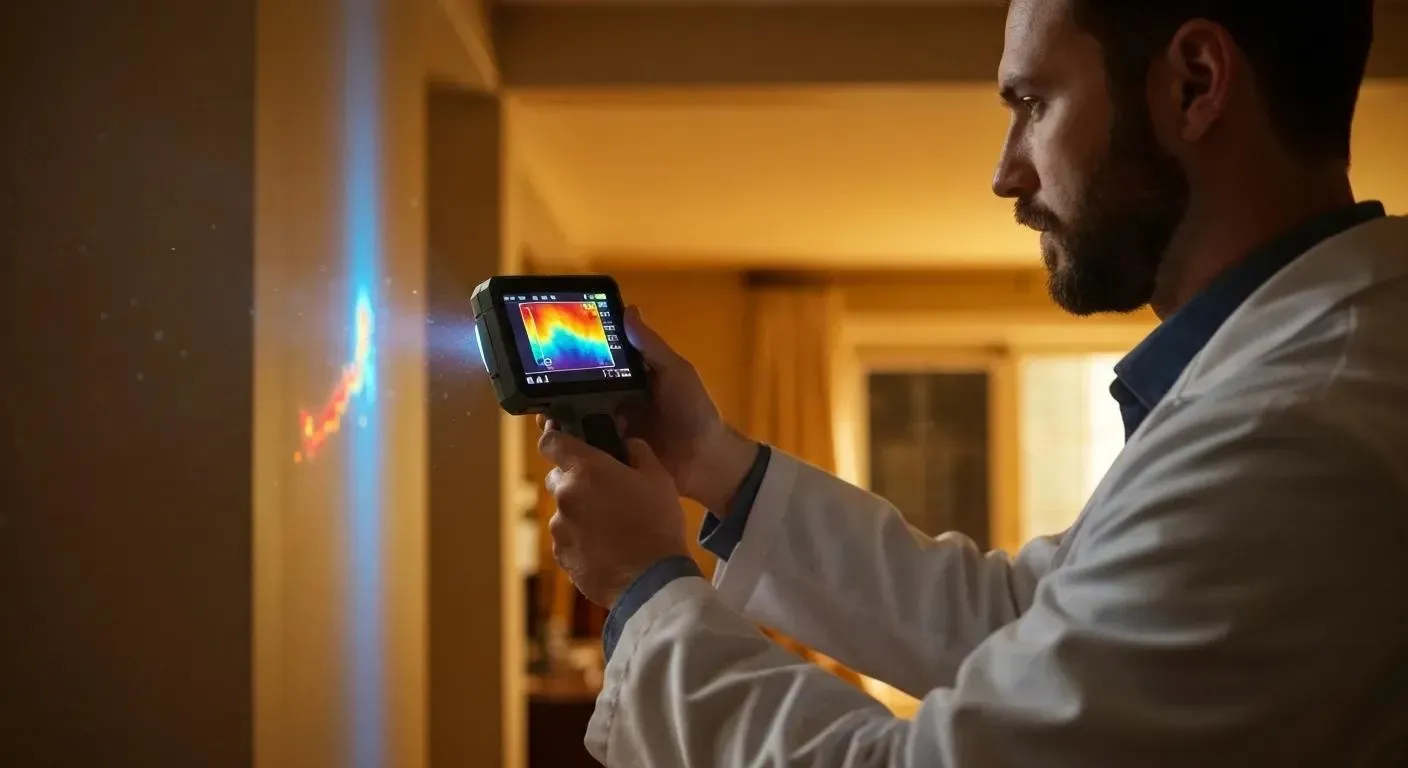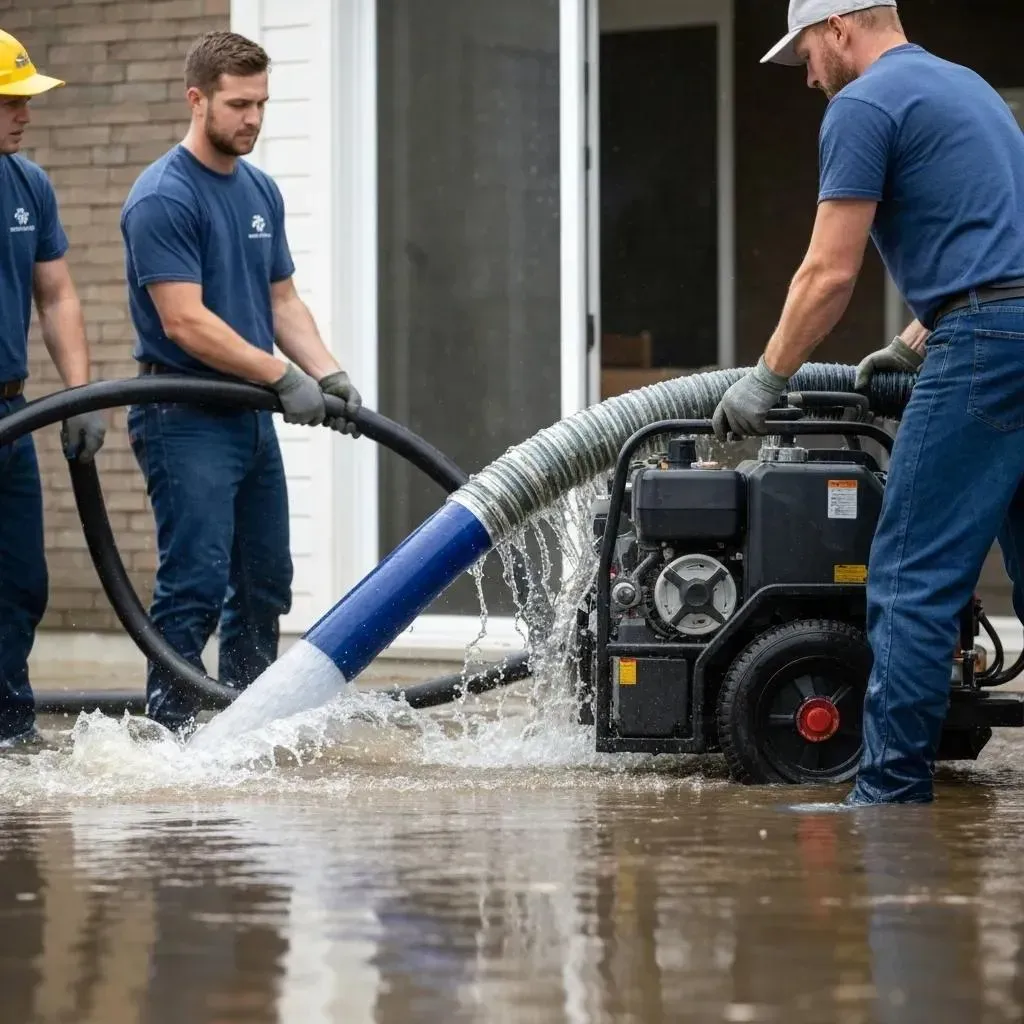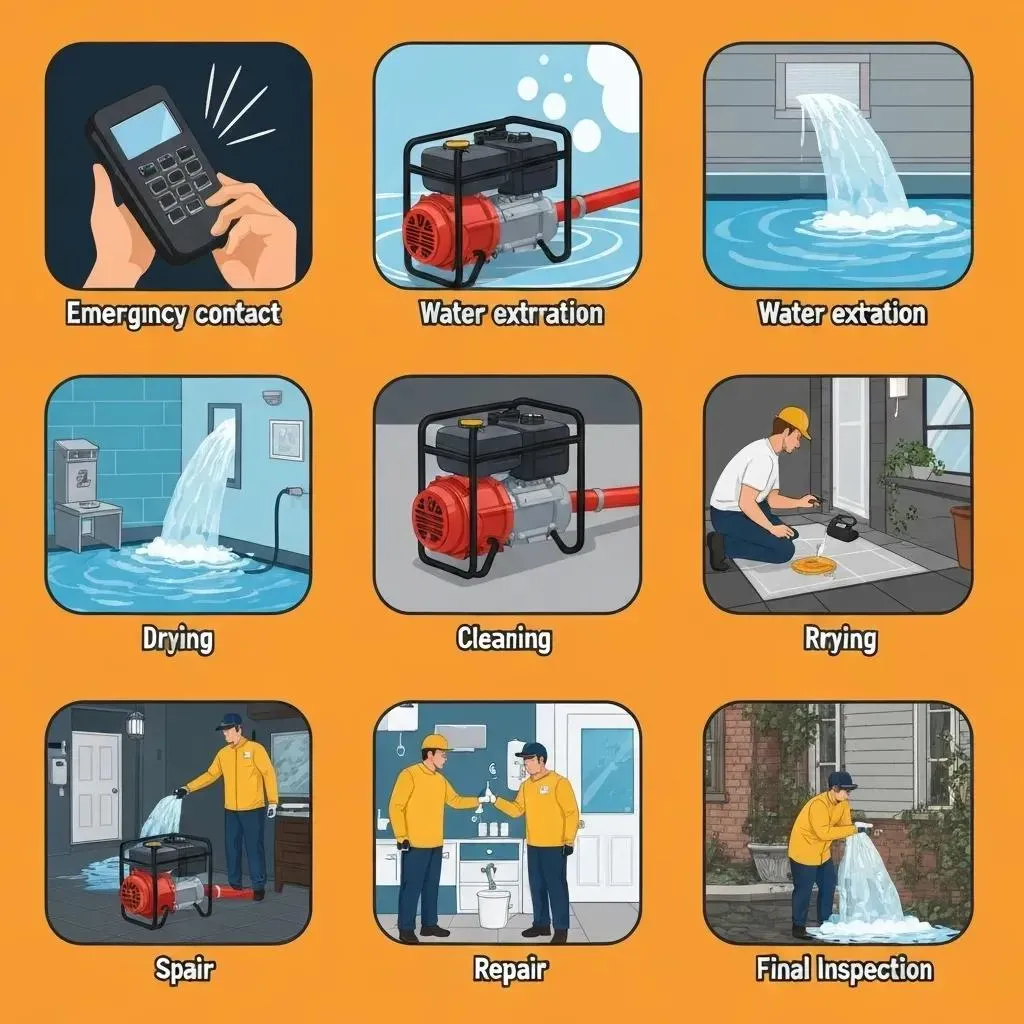Blog
The Critical First Hours: Why Water Damage Home Inspection Matters
Water damage home inspection is a systematic process of assessing a property for moisture intrusion and its effects using visual checks and specialized tools. This inspection identifies the source, extent, and severity of water damage to guide proper remediation.
Key Elements of a Professional Water Damage Inspection:
- Source identification - locating the origin of the leak or intrusion
- Moisture mapping - documenting the spread of water throughout the structure
- Damage classification - categorizing by contamination level and affected area percentage
- Documentation - collecting photos, moisture readings, and detailed reports
- Remediation planning - outlining necessary steps to restore the property
Water may be essential to life, but as a destructive force, it can diminish your home's value and create serious health hazards. Most concerning is how quickly damage escalates—mold can begin growing within just 24-48 hours after moisture intrusion, potentially leading to $5,000-15,000 in remediation costs.
What many homeowners don't realize is that most leaks go undetected until significant damage has occurred. The Environmental Protection Agency reports that household leaks waste approximately 1 trillion gallons of water annually across the United States, with much of this causing silent, progressive damage to homes.
When water enters your home—whether from a burst pipe, roof leak, or foundation seepage—it immediately begins a destructive journey through your property. Water follows gravity, often traveling far from the original source and creating damage in unexpected places. This is why professional inspection is crucial to trace water's path completely.
I'm Mike Martinez, owner of Accountable Home Services, with over a decade of experience conducting water damage home inspections throughout Denver and helping homeowners recover from moisture intrusion. My team and I have seen how early detection through thorough inspection can save thousands in repair costs.
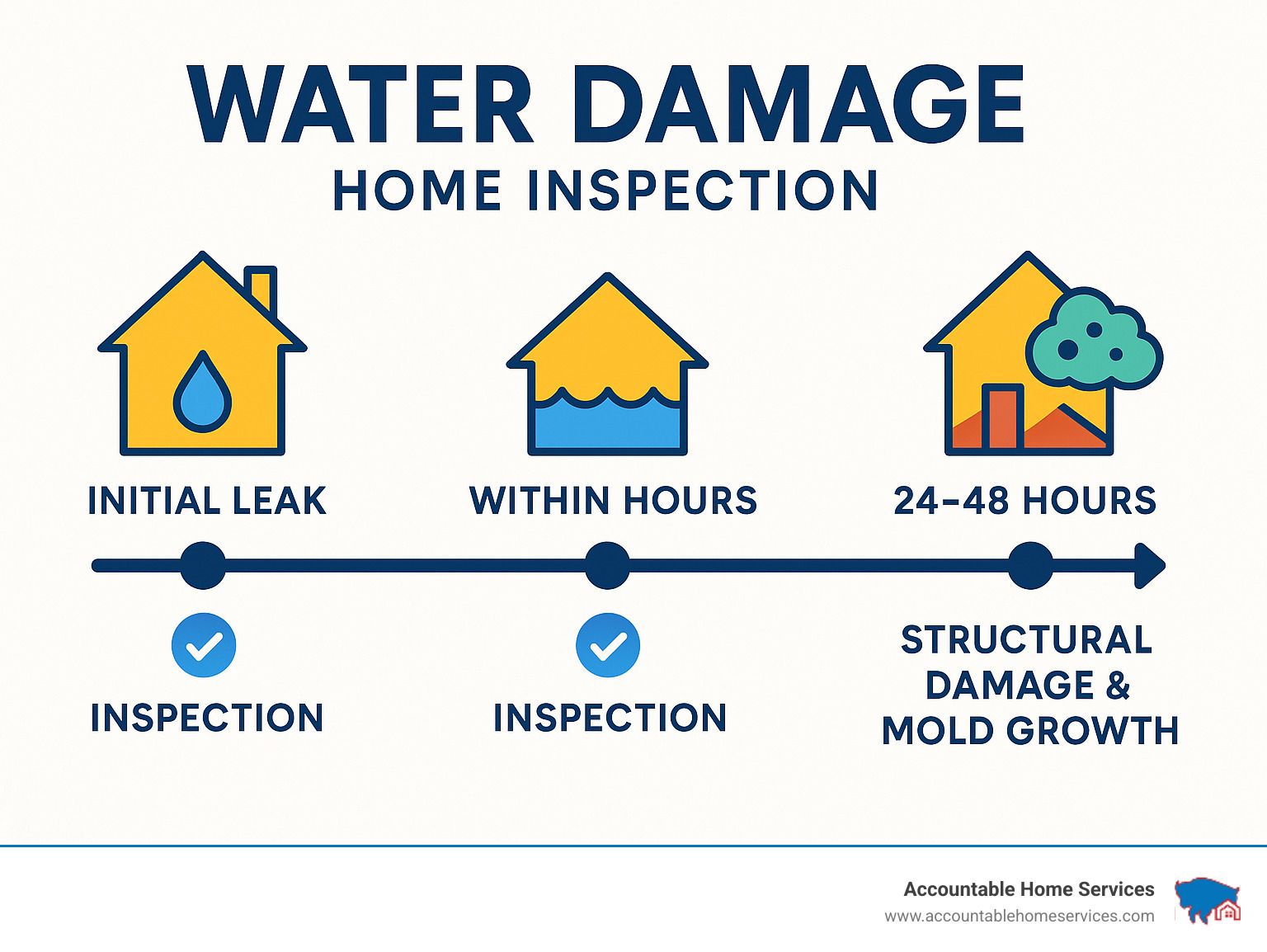
Water Damage Essentials: Causes, Classes & Categories
When water invades your Denver home, understanding what you're dealing with can make all the difference. As a homeowner, you're facing a unique challenge in our Colorado climate—where freeze-thaw cycles, sudden downpours, and snowmelt create perfect conditions for water damage.
Let me walk you through what I've seen in hundreds of Denver homes over the years. Water damage typically comes from five main culprits: natural disasters like our infamous flash floods, burst pipes (especially during those January cold snaps), sneaky roof leaks often caused by ice dams, appliance failures that send water cascading across your floors, and groundwater intrusion through foundation cracks.
What many of my clients don't realize is that not all water damage is created equal. The Institute of Inspection, Cleaning and Restoration Certification (IICRC) has established standards that guide how we approach your home's unique situation.
When I conduct a water damage home inspection, I'm looking at two critical factors: how much of your home is affected and how contaminated the water is.
The extent of water saturation falls into four classes:
Class 1 means we caught it early—less than 5% of your combined floor, wall, and ceiling surfaces show moisture. This is best-case scenario.
Class 2 indicates the water has started to spread, affecting between 5-40% of surfaces. I often see this with washing machine overflows that have had a few hours to soak in.
Class 3 is what keeps me up at night—more than 40% of surfaces are affected. Think burst pipe while you're on vacation.
Class 4 involves specialty materials like your hardwood floors, concrete, or plaster that require specific drying techniques.
"What might look like a small leak could actually be Class 3 damage if water has migrated into wall cavities and under flooring," explains Jeremy Brett, a certified restoration technician I often collaborate with in Boulder.
Equally important is understanding the contamination level of the water:
Category 1 is "clean water" from sources like a broken supply line—still a problem, but not an immediate health concern.
Category 2 is "gray water" containing some contaminants—think dishwasher overflow or washing machine leaks
Category 3 is "black water"—the stuff nightmares are made of, containing sewage or flood water from rivers or streams. This always requires professional handling due to serious health risks.
The Hidden Price of Delay
The clock starts ticking the moment water enters your home. During a water damage home inspection, I always emphasize this timeline because I've seen the heartbreaking consequences of waiting too long.
Within just 24-48 hours, mold can begin growing in ideal conditions. I've walked into homes where a small leak behind a refrigerator turned into a $15,000 mold remediation project simply because it went unnoticed for a few weeks.
The damage progression is relentless: first comes drywall disintegration and insulation compression, then wood starts to swell, and eventually, structural elements begin to rot. Your home's very foundation can be compromised—all while your property value potentially drops by 15-20%.
As veteran home inspector Scott Brown puts it: "By the time you notice that water stain on your ceiling, the problem has likely existed for weeks or even months."
This is why scientific research on household leaks is so alarming. The EPA reports that nationwide, household leaks waste about a trillion gallons annually—much of it silently damaging homes like yours.
For Denver homeowners, I strongly recommend seasonal inspections, particularly before winter sets in and after spring thaws. These transition periods are when water issues most commonly emerge in our climate. What might cost $500 to fix today could balloon into thousands if left unchecked.
At Accountable Home Services, we've seen how early detection through professional inspection has saved our Denver neighbors thousands in repair costs. Water may be essential to life, but when it's in the wrong place, quick action becomes just as essential.
Health & Structural Risks: Why Speed Matters
When it comes to water damage, time isn't just money—it's the difference between a minor repair and a major reconstruction. At Accountable Home Services, we've seen how quickly a small water issue can spiral into something far more serious for Denver homeowners.
Mold Growth & Indoor Air Quality
That musty smell after water intrusion isn't just unpleasant—it's a warning sign. Mold is nature's cleanup crew, always present in our environment, just waiting for the right conditions to multiply. And unfortunately, those conditions arrive quickly after water damage occurs.
"What many homeowners don't realize is that mold doesn't need standing water to thrive," explains Bud Coburn, a restoration specialist we often collaborate with. "Relative humidity above 60% provides enough moisture for mold growth. That's why maintaining indoor humidity between 30-50% is recommended."
During every water damage home inspection we conduct, we pay special attention to humidity levels throughout your home. Even areas without visible water can harbor hidden moisture—the perfect breeding ground for mold colonies that can establish themselves in as little as 24 hours.
The health implications can be serious. The CDC has documented how exposure to damp, moldy environments can trigger a range of health issues—from nasal stuffiness and throat irritation to more severe reactions in people with asthma or mold allergies. For vulnerable family members, these aren't just inconveniences—they're genuine health concerns that demand immediate attention.
Electrical & Foundation Dangers
Water and electricity make for a dangerous combination—one we take very seriously. When moisture infiltrates your home's electrical system, it creates immediate hazards that can't be ignored:
Water-damaged electrical systems don't always trigger obvious warnings. Moisture in outlet boxes causes silent corrosion, wet insulation degrades protective wire coverings, and in some cases, circuit breakers may not trip despite dangerous conditions developing behind your walls.
Just last month, our team inspected a Westminster home where the owner had noticed just a slight discoloration on their basement wall. Using our thermal imaging equipment, we finded extensive moisture behind the finished wall that had been silently seeping through a foundation crack. Most concerning? The water had already begun corroding nearby electrical conduit—a serious fire hazard that could have gone undetected without proper inspection.
The foundation of your home isn't immune either. Colorado's unique soil conditions make our foundations particularly vulnerable to water damage. The expansive soils common in Denver create hydrostatic pressure against foundations when saturated, while our famous freeze-thaw cycles can turn minor cracks into major structural concerns in just one winter season.
Water in crawl spaces undermines support posts, saturated soil shifts and settles unevenly, and repeated moisture exposure weakens even the most solid foundations over time. These aren't just cosmetic concerns—they're threats to your home's fundamental stability.
What makes these risks even more pressing is the changing landscape of insurance coverage. More insurance companies are excluding long-term water damage from policies, making early detection through professional water damage home inspection not just a safety measure but a financial necessity. A small investment in inspection today can prevent a devastating uncovered claim tomorrow.
At Accountable Home Services, we don't just identify these risks—we help you address them before they escalate, protecting both your home's structure and your family's health with prompt, thorough intervention.
Detecting Damage: Signs, Tools & Water Damage Home Inspection Process
Have you ever noticed a mysterious water stain on your ceiling and wondered what's lurking behind it? When it comes to finding hidden moisture in your home, it takes more than just a keen eye—it requires a methodical approach and the right tools. Let's walk through how professionals spot what you might miss during a water damage home inspection.
Top-Down Visual Sweep
We always start at the highest point where water might enter and follow gravity's path downward. It's like being a detective following water's trail through your home.
In the attic, we're looking for wet insulation that feels heavy in your hands, water stains on roof sheathing that look like coffee rings, and damaged flashing around chimneys that's pulled away from the surface. Here in Colorado, we pay special attention to signs of ice dam formation along eaves—a common culprit in Denver winters.
Moving to your living spaces, we examine ceilings and walls for telltale discoloration, paint that's bubbling or peeling away, and sagging drywall that feels soft to the touch. Your floors might whisper secrets about hidden leaks through warping hardwood, damp carpet that squishes slightly underfoot, or subfloors with suspicious soft spots.
Down in the foundation and basement, we're searching for white mineral deposits on concrete (called efflorescence), water lines marking previous flooding, and that unmistakable musty smell that often signals mold's presence.
As one of our Lakewood clients recently told me, "I just thought my wood floor was settling naturally. I had no idea the slight buckling was from my refrigerator's water line slowly leaking for months until your inspection found it!"
Advanced Toolkit Breakdown
Modern water damage home inspection has evolved far beyond the old "tap and listen" approach. Today, we use sophisticated equipment that can "see" moisture hiding deep within your walls and floors.
Moisture meters have become our most trusted allies, measuring exactly how wet materials like drywall and wood have become. When we get readings above 16% in wood or 1% in drywall, we know there's a problem brewing—often long before you'd see visible damage.
Thermal imaging cameras are perhaps the most impressive tools in our arsenal. As Mike from our team often explains to surprised homeowners: "These cameras don't actually 'see' water—they detect temperature differences. Wet materials change temperature differently than dry ones, showing up as distinct color patterns on our screen."
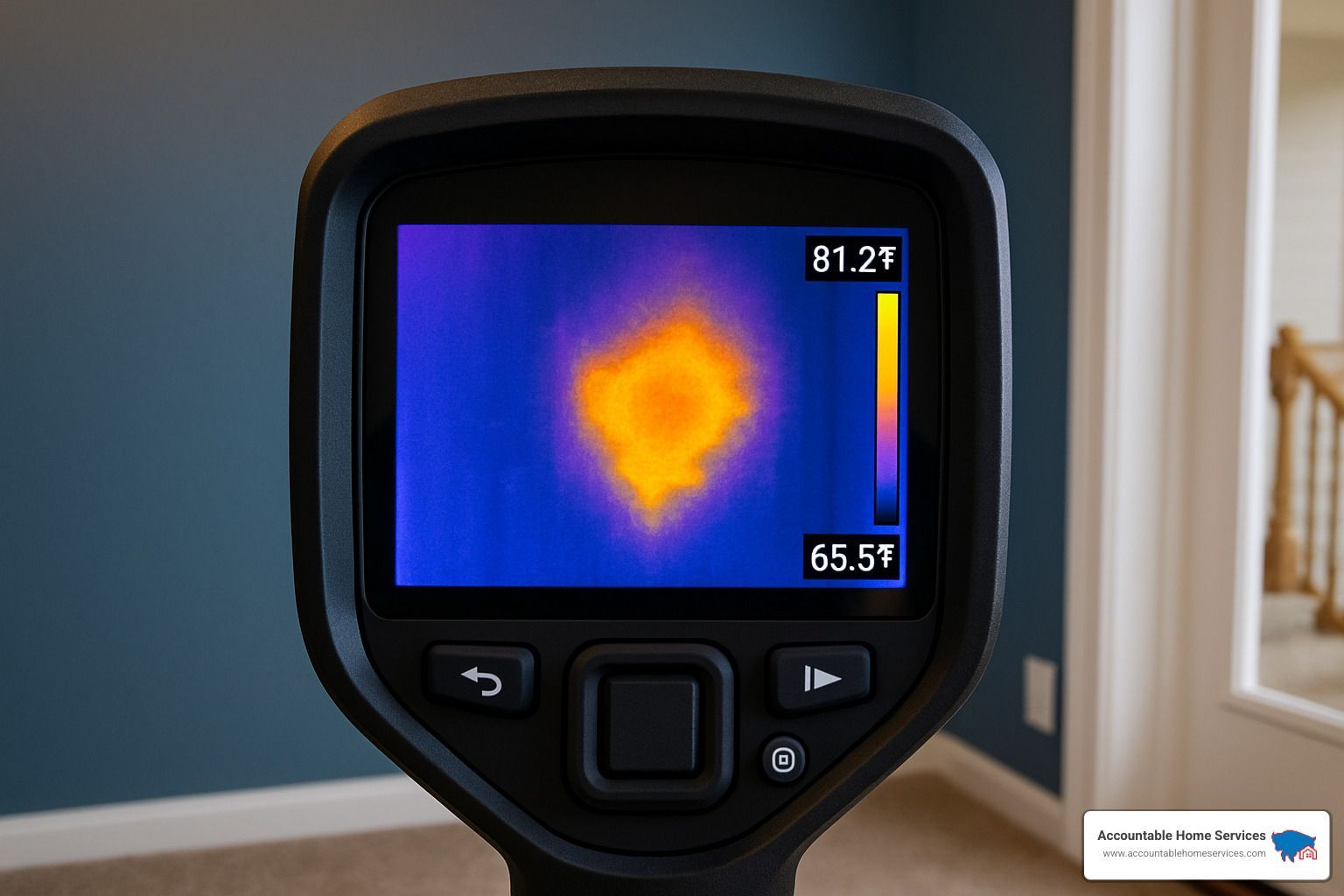
We also use hygrometers to measure the relative humidity in different areas of your home. When we find pockets of significantly higher humidity, it often leads us to hidden moisture sources. For those tricky situations where we suspect active leaks behind finished surfaces, our acoustic listening devices amplify the faintest sounds of dripping or flowing water.
When plumbing issues are the suspected culprit, we might deploy video pipe cameras that snake through your drain lines, revealing cracks, blockages, or tree root intrusions that would otherwise remain hidden.
At Accountable Home Services, we document everything we find with detailed photos, videos, and moisture maps. This comprehensive documentation not only helps guide repairs but provides essential evidence for insurance claims.
DIY vs Professional Water Damage Inspection
I'm often asked, "Can't I just check for water damage myself?" While I encourage all homeowners to stay vigilant, there's a significant difference between what you can spot and what our professional inspection reveals.
As a homeowner, you can certainly keep an eye out for obvious water stains, notice musty odors, and even use consumer-grade moisture meters to check suspicious areas. This regular vigilance is your first line of defense.
However, professional inspectors bring critical advantages: years of experience interpreting subtle signs of damage, commercial-grade equipment with much greater sensitivity, and comprehensive knowledge of how water moves through different building materials. We can safely access confined spaces, properly document findings for insurance purposes, and identify issues that might be completely invisible to the untrained eye.
A Highland homeowner recently shared with me, "After our minor flooding incident, I thought I'd handled all the cleanup myself. Thank goodness for your thermal imaging—finding that hidden moisture in my wall cavity probably saved me thousands in future mold remediation."
Step-By-Step Professional Water Damage Inspection
When we arrive at your home, our water damage home inspection follows a methodical process refined through years of experience:
First, we'll have a conversation about your home's history and any recent water events you've noticed. This initial interview helps guide our inspection—your observations provide valuable clues about where to focus our attention.
We'll then examine your home's exterior, checking drainage patterns, foundation condition, roof integrity, and potential water entry points. Poor drainage around your foundation is one of the most common issues we identify in Denver homes.
Moving inside, we conduct a systematic room-by-room visual inspection, starting at the ceiling and working our way down to the floors. We're looking for all those visible signs we mentioned earlier—stains, warping, and discoloration.
The heart of our inspection involves using our specialized equipment to detect hidden moisture. We'll take numerous readings throughout your home, creating a comprehensive moisture map that reveals what's happening behind your walls and under your floors.
By analyzing moisture patterns, we can typically trace the water to its source—whether it's a leaky pipe, roof penetration, or groundwater intrusion. We'll classify the damage according to industry standards and document everything with detailed photos and notes.
We'll also assess any safety concerns, such as electrical hazards or structural compromise, before compiling our findings into a comprehensive report. Finally, we'll sit down with you to explain what we've found and recommend appropriate next steps.
"Water follows the path of least resistance, which isn't always straight down," explains our senior inspector. "It can travel along pipes, wiring, or framing members, appearing far from its entry point. That's why our systematic approach is so important—we follow water's journey through your entire home."
When it comes to protecting your biggest investment, professional water damage home inspection provides peace of mind that DIY checks simply can't match. At Accountable Home Services, we bring the expertise, equipment, and experience to find what others miss.
Reporting & Insurance: Documentation, Questions to Ask, Who to Hire
When water invades your home, proper documentation becomes your lifeline—especially when dealing with insurance companies. As we've seen countless times at Accountable Home Services, the difference between a smooth claim and a frustrating denial often comes down to one thing: thorough documentation from your water damage home inspection.
Key Documentation Elements
Think of your inspection report as telling the complete story of your water damage. A good report doesn't just say "there's water"—it paints a detailed picture that insurance adjusters can't ignore.
Your inspection documentation should include moisture maps that visually show the spread of water throughout your home. These maps, combined with specific moisture readings from different materials, create an undeniable record of damage. Thermal images reveal what's hiding behind walls, while clear, well-lit photos capture visible damage from every angle.
"Insurance adjusters don't have crystal balls," explains Mike from our team. "They rely on what they can see and measure. When we provide timestamped photos and precise moisture readings, we're essentially giving them the evidence they need to approve your claim without question."
The best reports also identify the exact source of water entry and classify the damage according to industry standards—critical information that shapes remediation plans and insurance coverage decisions.
Key Questions for Hiring
Finding the right professional for your water damage home inspection can feel overwhelming when you're already dealing with a water emergency. Here are the questions that matter most:
Are they properly certified? Look for IICRC or ASHI credentials—these aren't just fancy letters after someone's name but proof they've been trained in industry best practices. At Accountable Home Services, all our technicians maintain current certifications that require ongoing education.
How thorough is their assessment process? A quick visual scan won't cut it. The professional should describe a systematic approach that includes moisture meter readings, humidity testing, and thermal imaging—not just eyeballing the damage.
I remember helping a family in Lakewood who had previously hired a "professional" who spent 15 minutes looking around before declaring everything "mostly dry." When we arrived two weeks later, we found extensive mold behind seemingly dry walls. A proper inspection takes time and tools.
What will your documentation include? Ask to see sample reports. Will you receive detailed moisture maps? Will photos be clearly labeled? Is the report organized in a way insurance companies can easily process?
How will they protect unaffected areas? Water damage can spread during inspection and remediation. Professionals should explain their containment procedures to prevent cross-contamination.
What equipment will they use? The tools matter. Consumer-grade moisture meters from the hardware store simply can't match the precision of professional equipment that can detect moisture deep within building materials.
Who Should Perform the Inspection?
Different water situations call for different experts. Understanding who to call can save you time and money.
Certified home inspectors provide unbiased assessments of your property's overall condition. They're particularly valuable during real estate transactions when you need to know if that dream home has hidden water issues. However, they may not have the specialized equipment for comprehensive moisture detection.
Water damage restoration technicians are your front-line experts when active water intrusion is happening. They come equipped with advanced moisture detection tools and can transition directly from inspection to remediation. This seamless handoff can significantly reduce your overall recovery time.
Insurance adjusters assess damage specifically for claim purposes. While they determine coverage based on your policy, they're not restoration experts. That's why we always recommend having your own restoration professional present during insurance inspections—they'll spot issues an adjuster might miss.
Mold remediation specialists become essential when water damage has lingered long enough for biological growth to begin. These experts focus on health risks and containment measures that go beyond standard water damage protocols.
"For the best outcome, especially after significant water events, having both a certified home inspector and water restoration technician present gives you the most comprehensive assessment," says Jennifer, one of our senior technicians. "It's like getting a second opinion that could save you thousands in overlooked damage."
Classifying & Coding the Loss
When professionals conduct a water damage home inspection, they don't just say "it's wet"—they precisely classify the damage to guide proper restoration:
Class 1 (Limited) affects less than 5% of your home's combined surface area. Think of a small bathroom overflow that only wet part of the floor. These situations typically require minimal equipment and dry relatively quickly.
Class 2 (Significant) involves 5-40% of surfaces—like when a washing machine hose breaks and floods part of your laundry room, affecting flooring and lower portions of walls. These situations require more equipment and monitoring.
Class 3 (Extensive) means over 40% of surfaces are affected. Imagine an upstairs water heater failing while you're at work, sending water cascading through multiple floors. These situations demand intensive equipment deployment and possibly opening walls for proper drying.
Class 4 (Specialty Materials) doesn't necessarily mean more water, but rather that the water has affected materials that are harder to dry—like concrete, hardwood, plaster, or brick. These situations require specialized equipment and extended drying times.
"These classifications aren't just technical jargon," explains our senior restoration manager. "They directly impact the resources needed for proper restoration. When a company underestimates the class, they might not bring enough equipment, leading to inadequate drying and secondary damage like mold growth."
At Accountable Home Services, we take the time to properly classify your water damage because we know it's the foundation of a successful restoration plan—one that returns your home to pre-loss condition as quickly and safely as possible.
From Inspection to Restoration: Immediate Steps & Prevention Tips
When your water damage home inspection reveals moisture issues, quick action can save you thousands in repairs and protect your family's health. As we often tell our Denver clients, water damage is a race against time – but with the right approach, you can win that race.
Homeowner Action Checklist
If you've just finded water damage, take a deep breath and then take action. Your first 24-48 hours are absolutely critical.
Start by stopping the water source – turn off your main water valve for plumbing issues or place a tarp over roof leaks if it's safe to do so. Next, ensure safety by cutting power to wet areas (water and electricity are a dangerous combination!) and donning appropriate protective gear like gloves and masks.
Before touching anything, document everything thoroughly. Your smartphone camera is your best friend here – take photos and videos from multiple angles to create a visual record for your insurance company. We've seen countless claims improved by good documentation.
Now it's time to protect your belongings. Place aluminum foil under furniture legs to prevent staining, remove valuable items from affected areas, and relocate electronics to dry spaces. As one of our Highlands Ranch clients shared: "Just lifting my bookcases onto foil saved my hardwood floors from permanent staining."
Finally, contact the professionals – call your insurance company to report the damage and reach out to certified restoration specialists like our team at Accountable Home Services. We often tell clients that what we can easily resolve on day one becomes significantly more complex and expensive by day three or four.

The Restoration Process
After your thorough water damage home inspection, professional restoration follows a proven sequence that turns your crisis back into a comfortable home.
The process begins with water extraction, where our technicians use specialized equipment to remove standing water. Different flooring types require different approaches – what works for tile might damage hardwood. Materials that can't be salvaged are removed at this stage to prevent further damage.
Next comes drying and dehumidification, the science behind restoration. We strategically place air movers to create evaporation while dehumidifiers capture that moisture from the air. Throughout this process, we conduct regular moisture monitoring to track progress and adjust our approach as needed.
Once everything's dry, we move to cleaning and sanitizing. This includes applying antimicrobials to prevent mold growth, treating odors with air scrubbers, and cleaning salvageable items and structures. As Mike from Aurora told us last month, "I was amazed that they could save our family photos – I thought they were goners!"
The final phase is restoration and rebuilding – replacing damaged materials, reconstructing affected areas, and conducting a final inspection to ensure everything's resolved. While drying typically takes 3-5 days, complete restoration may require 1-4 additional weeks depending on the damage extent.
Long-Term Prevention
After experiencing water damage firsthand, most homeowners become prevention enthusiasts – and for good reason! An ounce of prevention truly is worth gallons of water damage cure.
Inside your home, install water leak detection devices near appliances and major plumbing. These affordable sensors can alert you to leaks before they become disasters. Remember to inspect and replace washing machine hoses every 3-5 years (these are common failure points), maintain your HVAC system with regular professional service, and check your water heater's anode rods and pressure relief valves annually.
Outside your home, clean gutters and downspouts seasonally to prevent overflow. Maintain proper grading away from your foundation (aim for a 6-inch drop over 10 feet) and inspect your roof after severe weather events. If your basement is prone to flooding, install and maintain a reliable sump pump system.
Living in Denver brings unique seasonal considerations. Winterize exterior faucets and irrigation systems before freezes hit, monitor for ice dam formation during snowy periods, check your basement during spring snowmelt, and inspect window wells and foundation after heavy rains.
"In Colorado's climate, prevention isn't just about saving money—it's about peace of mind," shared a long-time Lakewood homeowner we worked with. "After dealing with water damage from a frozen pipe, we installed leak detectors throughout our home. Last winter, we caught a small leak before it became a disaster."
Cost Factors in a Water damage home inspection
Understanding inspection costs helps you budget appropriately when water damage strikes. A basic visual inspection typically runs $200-$400, while adding moisture meter readings increases the cost to $300-$500. For the most comprehensive assessment with thermal imaging, expect to pay $400-$700.
Several factors affect the final price, including your property's size and complexity, the accessibility of crawl spaces and other confined areas, whether invasive inspection is needed (removing materials to access hidden spots), and if you need emergency after-hours service.
At Accountable Home Services, we believe in transparent pricing based on your specific situation. For homes with confirmed water damage, we often apply the inspection cost toward subsequent restoration services if you choose us for remediation – just one way we try to ease the burden during stressful situations.
A thorough water damage home inspection is an investment that can save thousands in the long run by identifying the true extent of damage and preventing future issues. As we like to tell our clients, "Finding all the water now means not finding mold later."
Buying or Selling with Water Damage Findings & FAQs
Water damage can be a game-changer in real estate transactions. Whether you're the one with the checkbook or the one handing over the keys, knowing how to steer these murky waters is essential for protecting your investment and peace of mind.
For Buyers
If you're shopping for a new home, getting a dedicated water damage home inspection might be the best money you'll ever spend:
Before you even think about making an offer, do some homework. Check FEMA flood zone maps to see if the property sits in a high-risk area. During those initial walk-throughs, keep your eyes peeled for subtle signs of trouble – those faint water stains on the ceiling aren't just decorative features! If possible, research the property's insurance claim history to see if water issues have been a recurring theme.
When inspection day arrives, hire someone who specializes in water damage – not just a general home inspector. Try to be present during the inspection if you can; seeing problems gives you a much better understanding than just reading about them later. Make sure your inspector documents everything thoroughly with photos and detailed notes.
"When I was buying my home in Arvada, the inspector found signs of previous water damage in the basement," shares a recent homebuyer. "We negotiated a $7,000 credit at closing to address the underlying drainage issues. Without that inspection, I would have inherited a serious problem."
If water damage is finded, don't panic – but do get detailed repair estimates from qualified contractors. This information becomes powerful leverage for negotiating a fair price adjustment, seller-paid repairs, or credits at closing. Just make sure any agreed-upon work will be completed by licensed professionals who stand behind their work.
For Sellers
Selling a home with water damage history? Transparency is your best friend.
Before listing your property, address any known water issues proactively. This isn't just ethical – it's smart business. Get all repairs documented properly by professionals, and consider investing in a pre-listing inspection to identify potential red flags before buyers do. This gives you time to address issues on your terms rather than scrambling to meet a closing deadline.
During the selling process, be upfront about all water damage history – Colorado law requires this disclosure anyway. Having documentation of professional remediation ready to share shows buyers you've handled problems responsibly. When you've addressed issues properly, most buyers will be reassured rather than scared away.
If the buyer's inspection reveals new issues, review the report carefully and get your own estimates. In many cases, offering repair credits at closing is more practical than rushing to complete repairs under time pressure, which may lead to cutting corners.
"Transparency is always the best policy when selling," advises a real estate professional familiar with Denver's market. "Water damage that's been properly addressed and documented shouldn't significantly impact your sale. Undisclosed issues, however, can lead to failed transactions or even legal liability."
Frequently Asked Questions about Water Damage Home Inspection
What does a Water damage home inspection cover?
A thorough water damage home inspection is far more comprehensive than just looking for obvious leaks. Professional inspectors evaluate your entire property inside and out, starting with exterior assessments of drainage systems, foundation integrity, and roof conditions. Inside, they'll examine every living space including often-overlooked areas like attics, crawl spaces, and behind appliances.
Using specialized equipment, they'll conduct moisture testing of walls, floors, and ceilings, often employing thermal imaging to detect hidden moisture that's invisible to the naked eye. Your plumbing system will be evaluated for potential issues, and inspectors will assess for mold when applicable.
At Accountable Home Services, we don't just identify problems – we provide clear documentation with photos and moisture readings, plus practical recommendations for necessary repairs. We can even guide you through the insurance claims process and work directly with your insurer to minimize your stress.
How soon should an inspection happen after a leak?
When it comes to water damage, time is literally money. Ideally, you should have a professional inspection within 24-48 hours after finding any water intrusion. This critical window exists because mold can begin growing surprisingly quickly, while water continues silently migrating through your home's building materials.
Early documentation also strengthens insurance claims by clearly establishing the initial condition before secondary damage occurs. For Denver homeowners with suspected but unconfirmed water issues, we recommend seasonal inspections – especially after heavy snow or rain, or during our notorious spring thaw when hidden problems often reveal themselves.
Can I use the report for insurance and real-estate negotiations?
Absolutely! A properly documented water damage home inspection report is a versatile tool that serves multiple important purposes.
For insurance claims, our reports provide objective evidence of damage extent and cause, including professional classification of water category and class. We clearly distinguish between pre-existing and new damage, which can be crucial for coverage determinations. Our expert assessment of necessary remediation helps ensure you receive appropriate compensation.
In real estate transactions, these same reports support price negotiations based on documented issues rather than guesswork. They provide a clear scope of work for necessary repairs, helping distinguish between minor cosmetic concerns and serious structural problems. This transparency benefits both buyers and sellers by establishing a factual basis for fair negotiations.
At Accountable Home Services, we specifically design our inspection reports to meet strict insurance company requirements while simultaneously providing clear, jargon-free information that's valuable for real estate negotiations. We believe good information leads to fair outcomes for everyone involved.
Conclusion
Water damage home inspection isn't just another item on your home maintenance checklist—it's a critical safeguard for both your property investment and your family's wellbeing. Throughout this guide, we've seen how quickly water intrusion can transform from a minor inconvenience into a major financial burden and health hazard.
If there's one thing we've learned from helping thousands of Denver homeowners over the years, it's that timing is everything. Water damage waits for no one, and those first 24-48 hours can make the difference between a straightforward fix and a complex, costly restoration project.
Here in Colorado, we face unique challenges—freeze-thaw cycles that stress plumbing, sudden mountain downpours that test our roofing, and spring snowmelt that can overwhelm drainage systems. These regional factors make regular inspections not just reactive measures but smart, proactive investments in your home's longevity.
I've walked through countless Denver homes where small, undetected leaks silently caused thousands in damage over time. That's why at Accountable Home Services, we believe in thorough inspections using advanced moisture detection technology, combined with our deep understanding of local building practices and climate conditions.
Proper documentation isn't just paperwork—it's protection. Whether for insurance claims or real estate negotiations, a detailed professional report provides the evidence you need to protect your financial interests. Our reports are specifically designed to satisfy insurance requirements while clearly communicating the scope of any issues.
Perhaps most importantly, effective water damage resolution means addressing root causes, not just symptoms. That dripping ceiling might be fixed with a patch, but what about the roof leak causing it? Our approach focuses on complete solutions that prevent recurrence.
As a family-owned business serving the Denver Metro Area, we understand that your home is more than just a building—it's where your life happens. That's why we're committed to providing transparent, thorough service when it comes to protecting it.
Whether you're dealing with active water intrusion, suspecting hidden moisture issues, or simply being proactive about your home's health, we're here to help. For questions about water damage home inspection or to schedule a comprehensive assessment of your Denver-area home, reach out to our team at Accountable Home Services. Let us help you protect what matters most.

